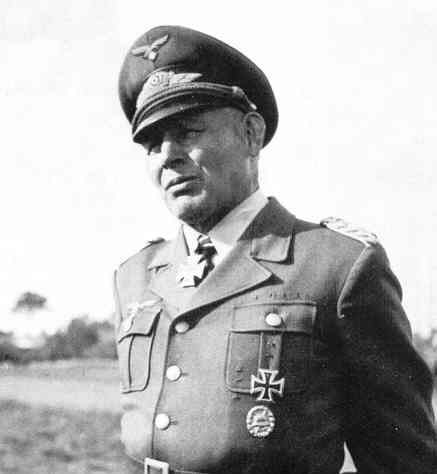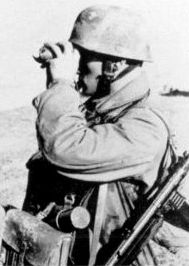| Alamein:
The German Parachute Brigade
By Mike Bennighof, Ph.D.
July 2017
 In the summer of 1942, German Luftwaffe Maj. Gen. Hermann-Bernhard
Ramcke, an experienced parachute commander, was on attached
duty with the Italian Folgore parachute division. Across the
Mediterranean, newly-promoted Field Marshal Erwin Rommel’s
German-Italian Panzer Army had reached El Alamein in western
Egypt where its advance ground to a halt. Rommel complained
that his army needed both more supplies and more German troops
to capture the Nile Delta and Suez Canal. In particular, he
claimed, he had to have two more panzer divisions. In the summer of 1942, German Luftwaffe Maj. Gen. Hermann-Bernhard
Ramcke, an experienced parachute commander, was on attached
duty with the Italian Folgore parachute division. Across the
Mediterranean, newly-promoted Field Marshal Erwin Rommel’s
German-Italian Panzer Army had reached El Alamein in western
Egypt where its advance ground to a halt. Rommel complained
that his army needed both more supplies and more German troops
to capture the Nile Delta and Suez Canal. In particular, he
claimed, he had to have two more panzer divisions.
Rommel’s Italian superiors did not have such formations
at hand, nor any prospect of acquiring them. They did, however,
agree to send more troops. Italian policy had been to send
smaller numbers of soldiers, in units of higher quality armed
with more automatic weapons than had been the case in 1941
and early 1942. Accordingly, they formally cancelled the long-delayed
Operazione C3 against Malta on 14 July 1942 and alerted the
185th “Folgore” Division to move to Egypt.

Hermann-Bernhard Ramcke.
Ramcke would not accompany them, at least not as an observer:
At about the same time, he received orders from Gen. Kurt
Student, commander of the German paratroop establishment,
to collect a brigade of airborne troops to move to Africa
along with Folgore. One of the rare German generals who spoke
Italian fluently, Ramcke seems to have been even rarer in
enjoying a genuine mutual liking and respect with his Italian
colleagues.
Ramcke’s scratch unit had four battalions of parachute
infantry, all originally intended for the Malta operation.
Battalion Kroh, formerly the 1st Battalion of the 2nd Parachute
Regiment, had recently fought in Russia and just moved to
the Mediterranean theater. Battalion Huebner had just been
formed, and had been intended to become the 2nd Battalion
of the 5th Parachute Regiment. Battalion Burkhardt had been
a Lehr battalion, one of the demonstration units of long-service
professionals the German armed forces used to show techniques
to other units and experiment with new weapons and tactics.
Finally, Battalion Von der Heydte had just been formed as
a new unit.
 
Ramcke also drew a parachute artillery battalion, the former
2nd Battalion of the 7th Flieger Division’s artillery
regiment, and an anti-tank company, a signal company and an
engineer company. They arrived at the Alamein position in
mid-August, greatly raising Rommel’s morale. He positioned
them alongside Folgore, and immediately committed them to
his new offensive, that became known as the Battle of Alem
Halfa.
Ramcke’s troops fought in mixed battle groups alongside
Folgore battalions and battalions from the Italian Brescia
Division and the German 90th Light Division. They suffered
serious casualties in a counter-attack by the 2nd New Zealand
Division, and the offensive ground to a halt. Rommel blamed the Italians
for handing over his battle plans, as was his way with all
his failures, but he had become predictable and the British
had established logistical superiority in the theater. While
the Axis was limited to bringing in light infantry formations
like Ramcke’s or Folgore, hundreds of modern tanks had
joined the British order of battle. They struck the Axis line
at the very end of September, in the Folgore sector, but the
paratroopers fought them off in hand-to-hand fighting.
British Gen. Bernard Law Montgomery now refocused his attack
well north of the two parachute units. The British broke through
the Afrika Korps’ lines just south of the coast, and
after heavy fighting Rommel ordered a general retreat. Germany’s
hero ordered the Italian 132nd “Ariete” Armored
Division to“fight to the last shot” while the German
motorized divisions fled along the coastal highway toward
Libya behind this sacrificial screen. The non-motorized Italian
units would be left behind as well.

A German paratrooper
in the Western Desert, 1942.
Positioned far from any German unit and lacking motorized
transport just like its Italian neighbors, Ramcke’s
brigade found itself written off by Rommel. Ramcke gathered
his men and marched westward, sure he would have to surrender
eventually but determined to put that moment off as long as
possible. Along the way, his men stumbled on a British supply
convoy stocked with food and cigarettes. Mounting up, the
paratroopers raced off to rejoin Rommel. About 600 of them
made it back to German lines, and the remnants of the brigade
finally surrendered in Tunisia in May 1943.
Ramcke escaped to be promoted to command 2nd Parachute Division,
which he led during its brief deployment in Russia in 1943.
The American landings in Normandy in 1944 found him again
serving under Rommel with his division, and he commanded German
troops in Brest after that key port was surrounded by the
Americans. Again refusing to surrender until the last possible
moment, he did not give up until American riflemen brought
his headquarters under fire.
In our Alamein game, Ramcke has one of the best tactical ratings of any leader.
His troops have excellent morale; the “7” rating
is the game’s highest. Their combat factors are quite
good for the most part, but they lack motorized transport
and much of an anti-tank capability.
Click here to order Alamein right now!
Mike Bennighof is president of Avalanche Press and holds a doctorate in history from Emory University. A Fulbright Scholar and award-winning journalist, he has published over 100 books, games and articles on historical subjects.
He lives in Birmingham, Alabama with his wife, three children and his dog, Leopold.
|
